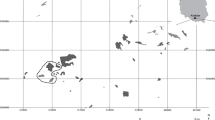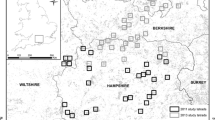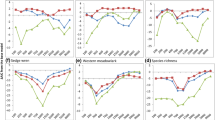Abstract
Community-level studies with finches have traditionally viewed local resources as the primary constrainst on local diversity. Patches have been considered to be self-contained and embedded in landscapes that were neutral with respect to the ecological processes under investigation. This study uses a factorial design to examine the relative roles of patch content and patch context in determining patterns of species richness. Sparrows were surveyed in small fallow patches that varied in both weed cover and the type of adjacent habitat. Species richness and total sparrow abundance were significantly influenced by both factors. Individual species were also influnced by both factors; however, responses were species-specific. Because occupation of particular plot types was conditional on their association with specific habitat types, the spatial patterning of species assemblages results from the configuration of patch types within the landscape.
Similar content being viewed by others
References
Brown JH, Lieberman GA (1973) Resource utilization and coexistence of seed-eating desert rodents in sand dune habitats. Ecology 54:788–797
Dunning JBJr, Danielson BJ, Pulliam HR (1992) Ecological processes that affect populations in complex landscapes. Oikos 65: 169–175
Emlen JT (1974) Population densities of birds derived from transect counts. Auk 88: 323–342
Forman RTT, Godron M (1986) Landscape ecology. Wiley, New York
Grubb TC, Greenwald L (1982) Sparrows and a brushpile: foraging responses to different combinations of predation risk and energy cost. Anim Behav 30: 637–640
Grzybowski JA (1983) Sociality and grassland birds during winter. Behav Ecol Sociobiol 13: 211–219
Lima SL (1990) Protective cover and the use of space: different strategies in finches. Oikos 58: 151–158
Lima SL, Valone TJ (1991) Predators and avian community organization: an experiment in a semi-desert grassland. Oecologia 86: 105–112
Pearson SM (1993) The spatial extent and relative influence of landscape-level factors on wintering bird populations. Landscape Ecol 8: 3–18
Pulliam HR (1975) Coexitence of sparrows: a test of community theory. Science 189: 474–476
Pulliam HR (1983) Ecological community theory and the coexistence of sparrows. Ecology 64: 45–52
Pulliam HR, Mills GS (1977) The use of space by wintering sparrows. Ecology 58: 1393–1399
Radford AE, Ahles HE, Bell CR (1968) Manual of the vascular flora of the Carolinas. University of North Carolina Press, Chapel Hill
Schluter D (1982) Seed and patch selection by Galapagos and ground finches: relation to foraging efficiency and food supply. Ecology 63: 1106–1120
Schluter D (1988) The evolution of finch communities on islands and continents: Kenya vs. Galapagos. Ecol Monogr 58: 229–249
Schneider KJ (1984) Dominance, predation, and optimal foraging in white-throated sparrow flocks. Ecology 65: 1820–1827
Schoener TW (1968) The Anolis lizards of Bimini: resource partitioning in a complex fauna. Ecology 49: 704–726
Strong TR, Bock CE (1990) Bird species distribution patterns in irparian habitats in southeastern Arizona. Condor 92: 866–885
Turner MG (1989) Landscape ecology: the effect of pattern on process. Annu Rev Ecol Syst 20: 171–197
Watts BD (1990) Cover use and predator-related mortality in song and savannah sparrows. Auk 107: 775–778
Watts BD (1991) Effects of predation risk on distribution within and between habitats in savannah sparrows. Ecology 72: 1515–1519
Werner EC, Hall DJ (1976) Niche shift in sunfishes: experimental evidence and significance. Science 191: 404–405
Zonneveld IS, Forman RTT (eds) (1990) Changing landscapes: an ecological perspective. Springer, Berlin Heidelberg New York
Author information
Authors and Affiliations
Rights and permissions
About this article
Cite this article
Watts, B.D. Landscape configuration and diversity hotspots in wintering sparrows. Oecologia 108, 512–517 (1996). https://doi.org/10.1007/BF00333728
Received:
Accepted:
Issue Date:
DOI: https://doi.org/10.1007/BF00333728




